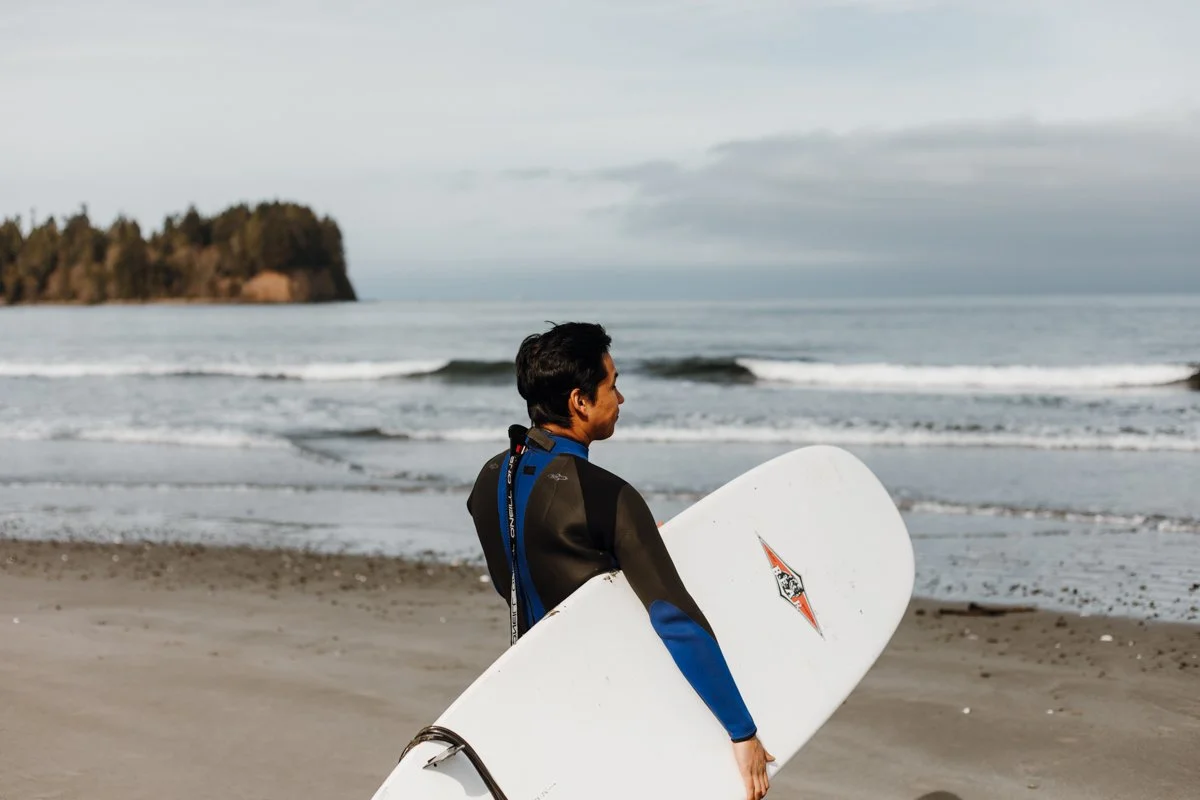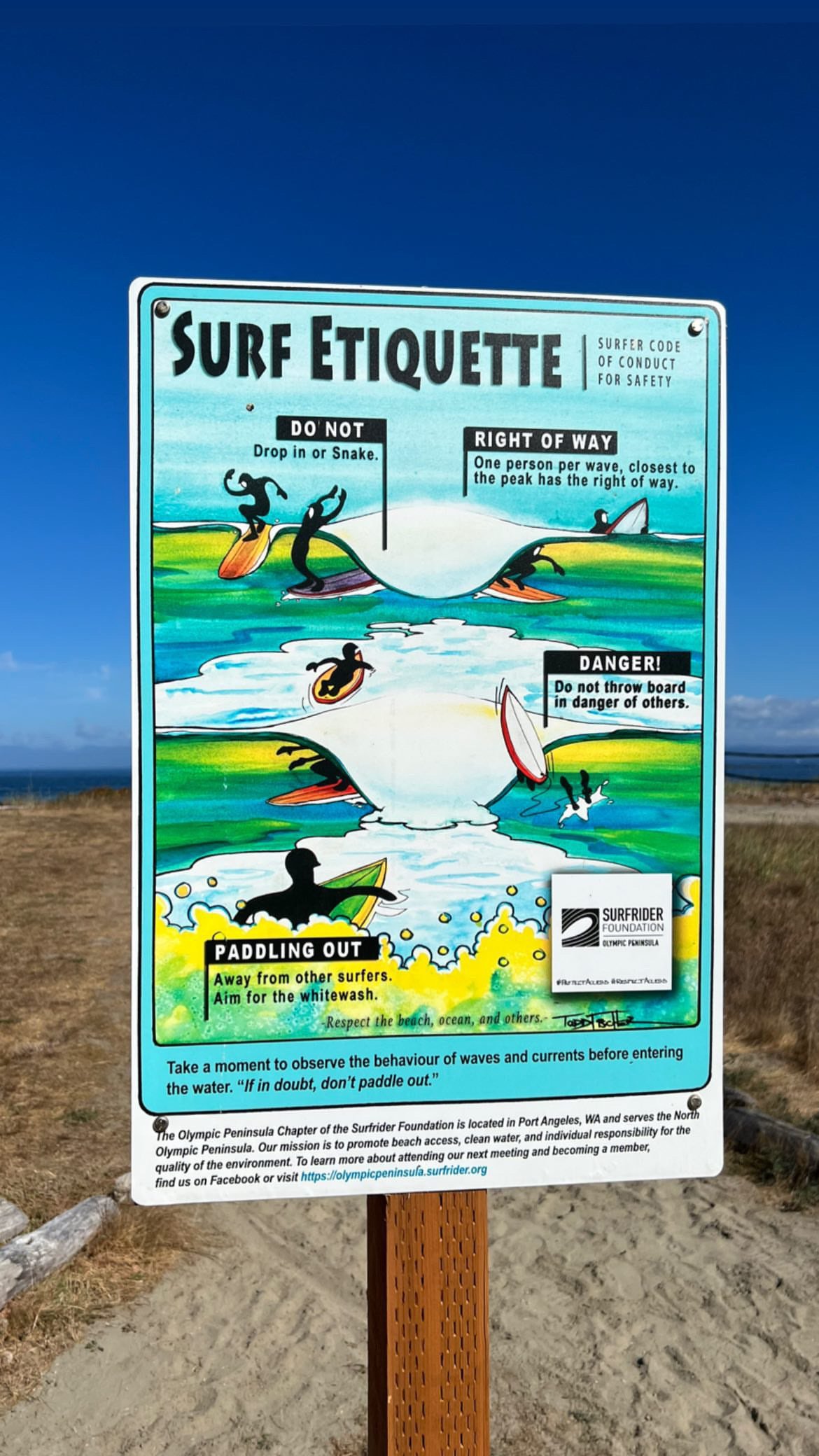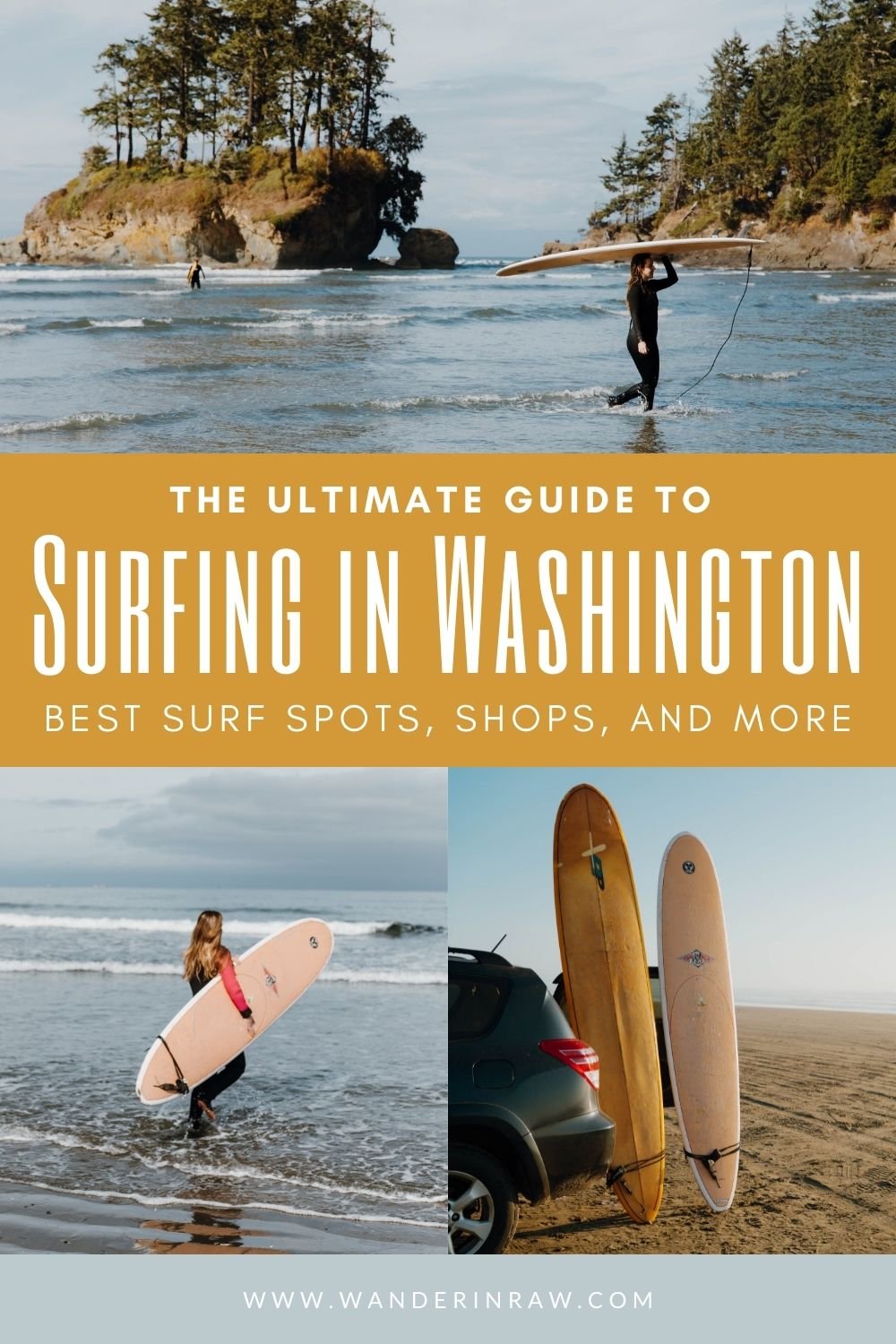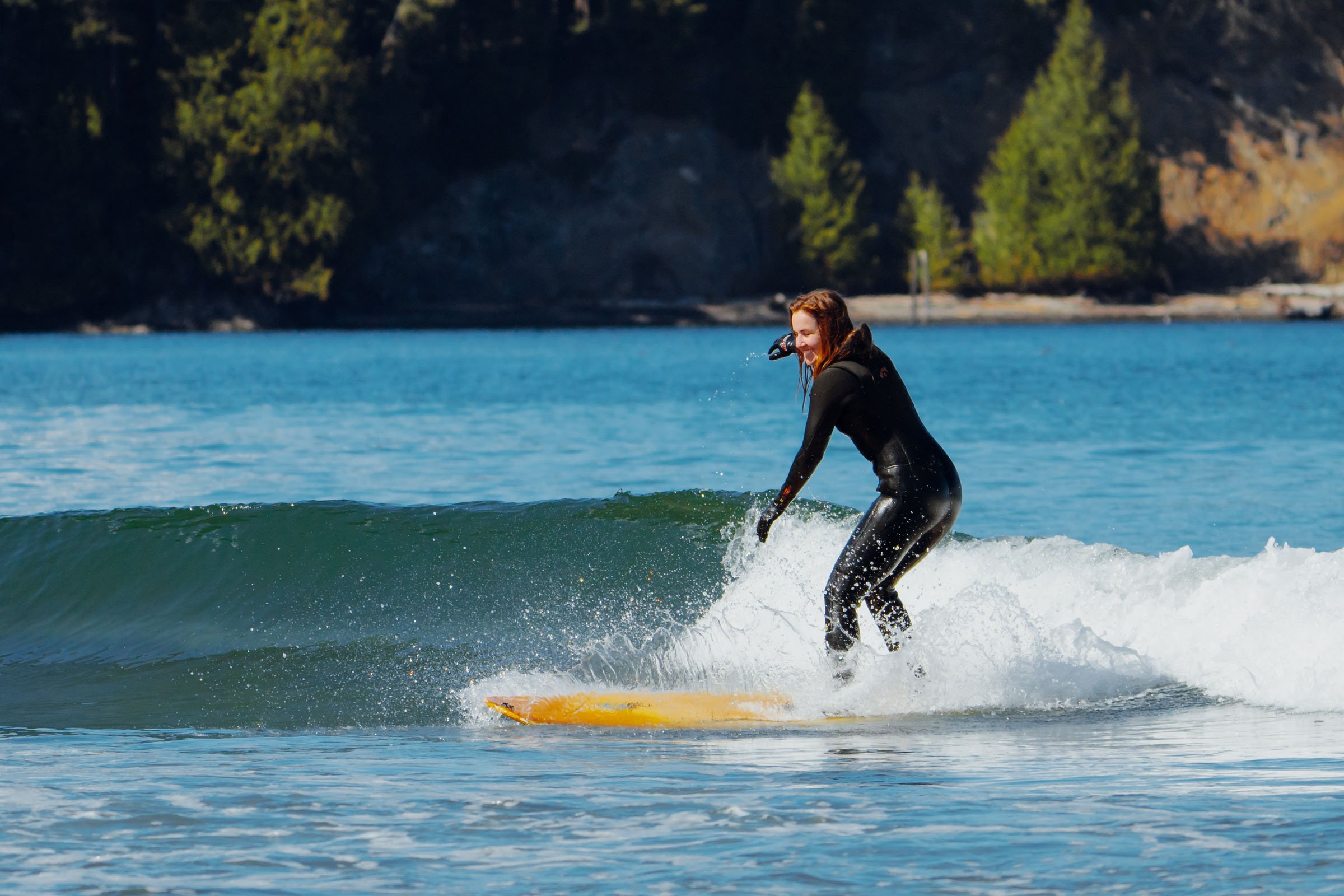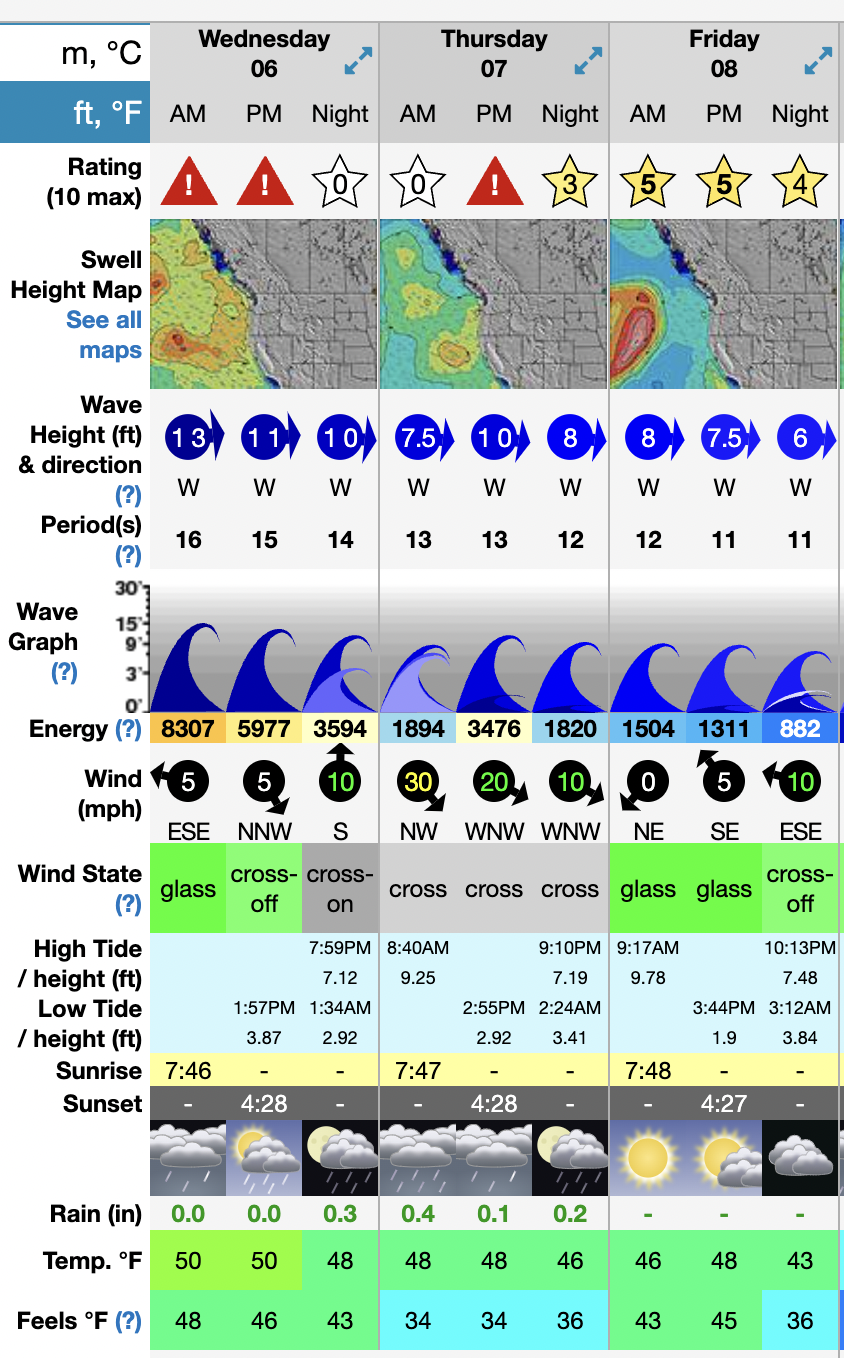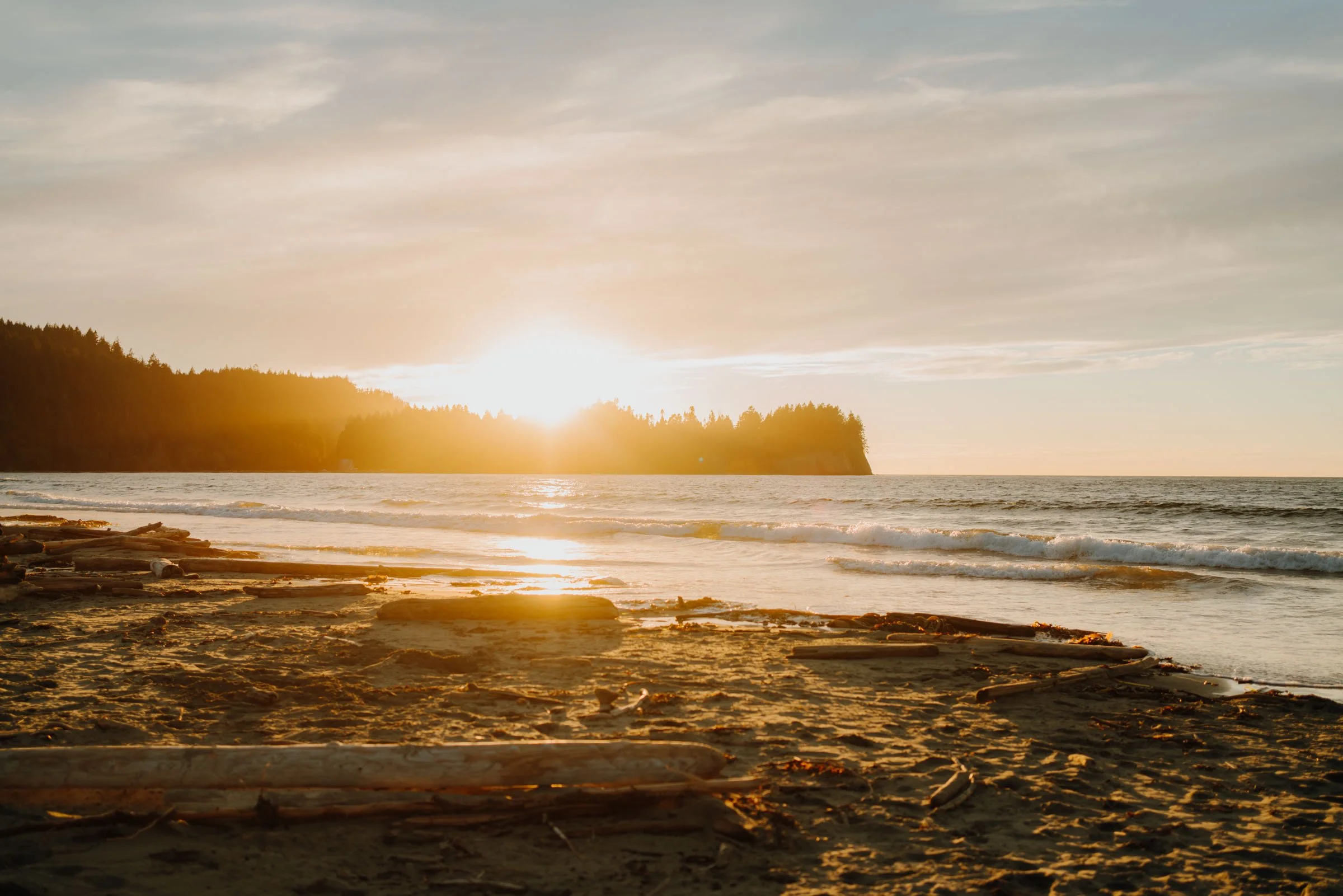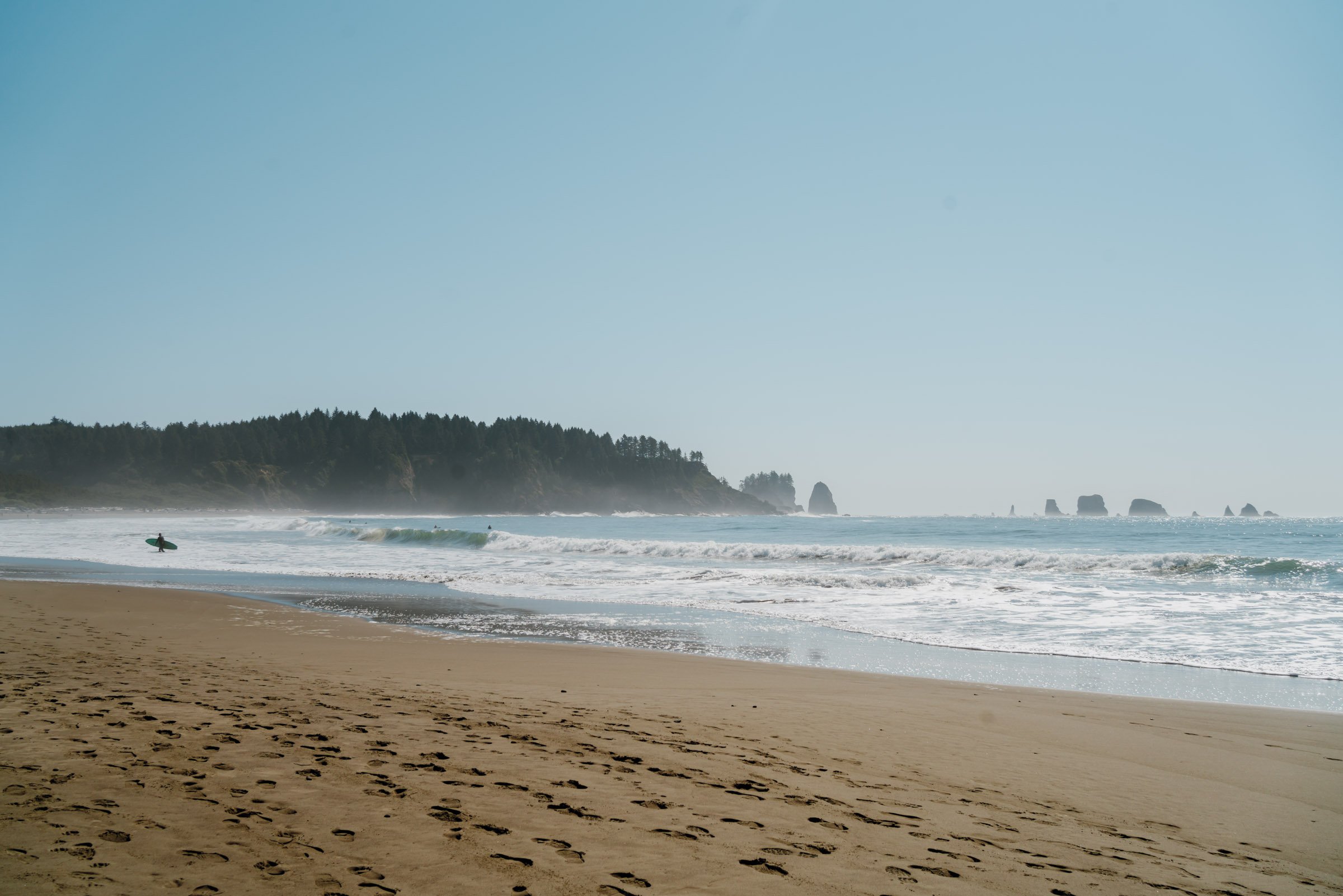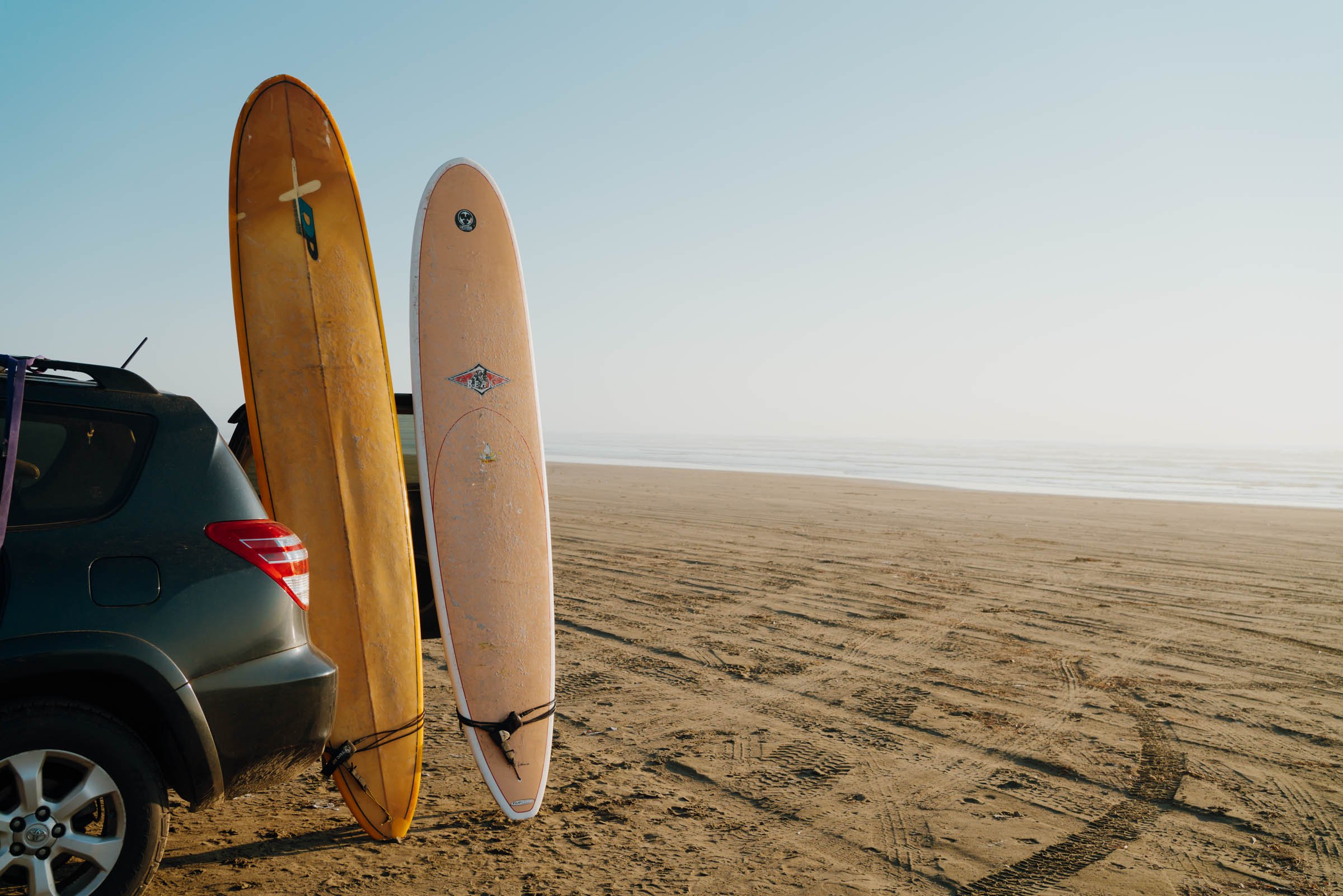Surfing in Washington: The Best Washington Surf Spots and Shops
If I had a surfboard for every time I heard, “What?! You go surfing in Washington? Isn’t it cold?” I could equip every single surfer in Washington state. Okay, okay, yes, it’s cold at first–a wetsuit definitely helps–but riding out there in our stunning coastal waters, saltwater in my hair, among sea stacks, seals, and shorebirds, often with the entire surf break completely to myself, is well worth that short, initial cold water shock. You get used to it! And the reward is steep.
Whether you’re a beginner hoping to paddle out for the very first time, or an experienced surfer looking for a few new surf spots, oooo have I got the blog post for you!
Read on for everything you need to know to go surfing in Washington, including some of my favorite surf spots, shops, and more!
Waxing a surfboard at Crescent Beach
Shoutout to Alki Supply for sponsoring this post, which is a goods and apparel shop with beanies, adventure hats, stickers, pins, and patches that celebrate Washington State. “Alki” was actually placed on the territory seal for Washington before it even became a state–you could say it’s the unofficial motto!
I also love recommending the gear and stays that I'm stoked about. As such, this post contains affiliate links to some of the products I love, and I'll receive commission upon any purchases made through those links at no expense to you. All opinions are always my own.
Table of Contents
FAQ
Is there surf in washington?
Heck yes! And it’s pretty dang good too! That is, if you know where to go, which is what I’m here for *wink!
Where are the biggest waves in washington?
The biggest waves, period? I’m going to go out on a limb and say Cape Disappointment, only because the spray from those massive winter storm swells hitting the rocky coastline puts on a pretty impressive show.
Do people surf on the Washington coast?
Yes! In fact, the Pacific Ocean delivers some of Washington’s best and most consistent waves. Read on for all the deets.
Surf Lingo
I’ll be using some specific surf jargon throughout this post. Here’s a quick guide to some common surf terms and what they mean!
Swell: A succession of waves that don’t crest (or break)
Sets: Ocean waves that typically come in a series of seven
Beach break: Waves that break because of a gradual sandy slope
Reef break: Waves that break over areas of reef. Because we’re in Washington, we’ll experience some rocky reef breaks
Point break: A wave that breaks off of a point, peninsula, or headland
Left-hand break (or left break): A wave that breaks to the surfer’s left
Right-hand break (or right break): A wave that breaks to the surfer’s right
Soft top or foam top: Boards that have foam on the top side, so if it hits you in the head it doesn’t hurt!
Hard top: Boards that are what you’d imagine a typical surfboard to be: usually made of wood, polyurethane, or epoxy
Outside: Refers to the waves farthest out. They’re the first catchable waves.
Inside: Refers to the white water, or the second wave breaks, closer to the beach.
Watching the waves before paddling out at Crescent Beach
Surf Safety
8 Checks for Safe Surfing:
Surf with a buddy
Going in pairs allows you to keep an eye on each other and call for the other in case of an emergency.
Tell someone you’re going surfing
Let someone know when and where you’re going out and when you expect to be back.
Check weather and tides
Before you set out, check the local forecast for wind, swell, and tide.
Know your limits
It’s easy to be caught out. Don’t challenge yourself too early and know your limits.
Be aware of rip currents
Look for areas where you think there should be waves, but there aren't. This could be a sign that it's a rip current. If caught in a rip current, don't panic! They're not going to drag you under, just take you for a little joy ride. Swim with it and slowly out to the side to conserve energy. You'll eventually escape the current and swim back to shore.
Always wear a leash
You don’t want to get separated from your board.
Wear the right wetsuit
As well as keeping you warm, wetsuits give some added protection from scrapes on rocks or impacts from other surfboards. Evo has a great guide for choosing the best wetsuit for you.
Understand surf etiquette and rights of way
Consider other surfers and water users. Running into another surfer or swimmer could result in serious injury. Make sure to give them some space.
Leave No Trace
Always remember to leave no trace.
Avoid using plastic and pack out all trash
Consider using plastic alternatives like reusable glass containers and compostable baggies to eliminate the possibility of plastic escaping with a strong gust of wind and impacting the ocean’s ecosystem.
Poop ahead of time!
Many of the surf spots listed in this post have bathrooms, some do not. If nature calls, pack it out! Bring a compostable baggie and do your business. Do not leave it on the beach. I repeat, do not. Human waste disposal in intertidal zones is illegal.
Admire wildlife from a distance, and be prepared to give them space if they get close
Leave wildlife plenty of elbow room. Getting too close will put them on edge and could put you in danger too!
Only build fires in designated fire rings or bring a stove
Check the rules and regulations of the beach you’re going to before building a fire. Some allow fires below the high tide line with local driftwood, others may not.
Look down! Are you crushing a mussel?
It may not seem like it, but even those kelp-covered rocks are teeming with wildlife! Be mindful of where you step.
Read more about leaving no trace in coastal ecosystems here.
Photo in collaboration with Juvy
How to Read a Surf Report
Don't forget to check the surf report before you go! Waves range from flat to 12',–beginner to expert–depending on the day and season. Don't put yourself in a sketchy situation just because you want to paddle out. Only surf what you're comfortable with.
Waxing a surfboard at Crescent Beach
I like to use Surf Forecast to check surf reports before I head out.
Choose a surf spot from the dropdown menu (you may even discover a few you never knew existed!) to see everything you need to know to decipher whether or not it’s going to be a good surf day for you!
Each day is separated into three time slots: AM, PM, and Night. Keep an eye out for those scary, red exclamation points and stay out of the water if those show up on your report! Take a gander at the swell map to decipher wave heights and where they’ll be hitting.
Then, the blue circles have the wave height in feet with an arrow showing which direction they’re hitting the beach.
The periods tell you how many seconds are between wave crests. The wave graph shows heigh and energy. Below is the wind in mph and if the wind state is green, that means wind conditions are perfect for surf.
High and low tides are important to keep in mind, especially if you’re surfing reef breaks. Rain and temp are less important but still good to know!
If you forget what any of these stats mean, roll over the little blue question mark with your curser to refresh the memory.
Okay, so what’s a good forecast? So happy you asked.
You’ll get a good feel for your ideal wave size. If you’re a beginner, I’d look for 2-3’ waves
Again, the more seconds between sets the better, in my opinion
Swell direction depends on the specific spot you’re going to. Ideally, you want a swell that comes in without any obstacles. If your surf spot faces northwest, you’ll want a swell from the northwest.
15 mph winds are strong, but not a deal breaker. You’ll start to understand how wind affects your surf the more you do it!
And lastly, green is good. If the direction is favorable to the surf spot you’re researching, the wind direction will be green. If it’s going to cause a gross, choppy, swell, it’ll be red. If that happens, go somewhere else. Trust me
Pro tip: Offshore winds are favorable, which is when the wind blows from shore out to sea rather than from sea on to shore.
Crescent Beach
Where to Find Surf Rentals and Lessons
Seattle
Surf Ballard
If you’re coming from Seattle, Surf Ballard will rent you a board, wetsuit, booties, and gloves for $70/day, $100 for two days, or $130 for three.
Urban Surf
Urban Surf is another great North Seattle surfboard shop, offering boards for $45/day or less depending on the type of board you’d like.
Camping at Crescent Beach with our boards
Port Angeles
North by Northwest Surf Shop
If you’re surfing the Strait during the summer months, North by Northwest Surf Shop in Port Angeles will hook you up. Unfortunately, they’re only open May through September, so keep it in mind for your summer surfing adventures! Lessons are also available.
Northwest Board Room
If you’re off to Crescent Beach, Northwest Board Room just opened a beachfront surf hut in 2022. They have wetsuits, booties, surf boards, and stand up paddleboards for rent. Hours and supply are limited, so call ahead! Lessons are also available.
La Push
La Push Surfing Adventures
La Push Surfing Adventures offers rentals and lessons with its own surf camp called The Farm, primed for ultimate relaxation in nature. Call ahead to reserve your rentals or book a lesson!
Ocean Shores
North Coast Surf Shop
Probably my favorite surf shop in Washington, North Coast Surf Shop has a solid selection of wetsuits with the option to add booties, gloves, and a hood, and surfboards, bodyboards, and skimboards and I love its character. They have sweet gear, swag, and suits for sale too. It’s where I bought my wetsuit!
Westport
The Surf Shop
Another spot with character, the Surf Shop has basic wetsuit and board rentals for a total of $30, and the shop is super fun too!
Steepwater Surf Shop
Steepwater takes it a step further than the Surf Shop with an advanced rental option that gives you access to a variety of demo boards of all sizes. Combined with a wetsuit and booties, you’re looking at about $51 for the day.
The beginner surfer’s package, which comes with a basic soft top/foam board and a wetsuit with booties for $39/day
Post-surf beach bonfire at Seabrook
LOGE Westport
If you’re looking to test out some top-notch performance boards, rent with LOGE. They have a few options to choose from, starting from $45/day excluding wetsuits ($18). Soft top/foam boards and intermediate hard top boards are also available.
The Best Surf Spots in Washington
Crescent Beach
Crescent Beach
Crescent Beach is a privately owned and operated little-known surf camp next to Salt Creek Recreation Area. (Definitely check that out too if you have time!) For $8 a day, surfers get beach access, parking, complimentary wifi, and access to a gear rinse station, bathrooms, and hot quarter-operated showers. It’s also where you’ll find Northwest Board Room, which is a little surf hut with rentals right on the beach!
Nothing like a camp bonfire after a surf sesh!
Here’s everything to know about surfing at Crescent Beach!
Where to Stay in Crescent Beach
RV, sites, tent camping, and two cabins are available for an overnight fee. Check rates and availability here.
Salt Creek Recreation Area
Camping at Salt Creek Recreation Area
Salt Creek Recreation Area is right next door and offers beautiful camping options for those who plan in advance! Reservations are available February through October and book up fast. Reserve here ($10 reservation fee). All other months are first come first serve!
Whiskey Creek Cabins: 20 oceanfront cabins and a-frames–some almost resembling treehouses–sit at the ocean’s edge just a 17-minute drive from Twin Beach and a 15-minute drive from Crescent Beach.
Read More: Why Salt Creek Recreation Area Should be on Your Must List!
Surfing at La Push, First Beach
La Push First Beach
La Push, baby! First Beach is a gorgeous, sandy bay with a stunning sea stack backdrop, and a popular spot to paddle out in summer and fall. Unfortunately, its moving sandbars and steep beach drop-off make the beach break a little unreliable any other time of the year. The good news is, you can check the beach’s webcam before full sending it to see if there’s a swell worth riding.
Worst case, you spend a day on La Push’s beautifully rugged coast and grab a warm meal with a view at the River’s Edge Restaurant.
Surfing at First Beach, La Push
Where to Stay in La Push
Quileute Oceanside Resort: With 33 oceanfront cabins, two motel units, 10 camper cabins, a campground, and two full-service RV parks at the edge of the ocean, the options are endless and the surf a plenty. No strapping on the boards to drive to the spot, it’s just a few steps away!
Sol Duc Den-West: This adorable little studio cabin has three beds and an outdoor fire pit just outside of Forks and on the outskirts of Olympic National Park. It’s the perfect basecamp for your surfing adventures!
Ocean Shores
Ocean Shores
This popular West Coast vacation spot offers two sweet surf spots: North Jetty and Damon Point.
NORTH JETTY
The North Jetty is the most frequented of the two–it’s a sandy bottom with a jetty surfers can use to their advantage.
Pro tip: If you want to get out past the white water fast, catch a ride with the water flowing back out to the ocean along the jetty. Think about it, the waves come in, and the water has to go back out somehow! The jetty guides it back out to sea. It’s basically an expressway!
The surf spot delivers a relatively consistent beach break (consistent meaning there are always going to be waves of some type), best with a southwest swell and light or east winds, but remember, we’re ocean surfing here! Rip currents are expected and weather can change in an instant. Just be a savvy surfer!
DAMON POINT
If the waves are a little too massive, Damon Point is an awesome option and it’s PERFECT for beginners or those who want a chill longboard session. It’s at the end of Protection Island, which is actually a peninsula, and pops off in nearly any swell direction. The clincher is the ocean swell needs to be about 5’ for it to reach the bay. Unlike the North Jetty, Damon Point requires a 15-minute walk down to the beach break, but don’t let that deter you!
Where to Stay in Ocean Shores
Rent your own adorable and totally private, two-story Sea Breeze Cottage right in town and just a 15-minute walk from the beach!
Waxing a surfboard.
Hobuck/Neah Bay
Consistent surf year round? Yes, pleaseeee. Hobuck is an exposed beach with a dependable beach break that’s best with offshore winds from the east and swells from the west. Located on the Makah Reservation, this Neah Bay surf spot offers surfers a bit of variety with lefts and rights, which is so ideal. It’s also out there at the northernmost tip of the continental US, so the drive is long but the crowds are few. As with any ocean surf, keep an eye out for rip tides and enjoy having beautiful breaks almost entirely to yourself.
Know Before You Go
All visitors must purchase a recreation permit at Hobuck Beach Resort for $20 per vehicle to park and use the beach. These permits are valid for one calendar year.
Where to Stay in Hobuck
Hobuck Beach Resort offers 26 cabins, 10 RV sites, and space for about 300 campers right at the water’s edge. Some cabins are even dog friendly! Nothing like waking up and walking 5’ for a sunrise surf, am I right?
Surfing at Westport, Washington.
Westport
Westport, Washington, is probably the most famous surf spot in Washington for its consistency, frequency of clean breaks, variety of difficulties, and easy access. There are three main surf spots: The Jetty, the Groins, and the Cove at Half Moon Bay.
THE JETTY
Rare are the days there isn’t a single wave at the jetty. With a reported 300 days of surfable waves, there’s nearly always something to surf, and the sandy bottom and ample white water makes it the perfect place to paddle out if you’re just learning. It’s the first Washington spot I surfed, but I’ll be honest, when I found out about the other surf spots, I haven’t been back. Lemme tell ya why.
It’s always crowded (by Washington standards, so the lineup isn’t bad but the parking is limited), and I’m exhausted by all the white water I’ve had to paddle through by the time I get to the outside, even if I catch the expressway along the jetty. Additionally, the waves here get a little too big for my comfort level, and every day ends in utter exhaustion and a few decent poundings.
(Note the expressway is a rip current–advanced surfers use them to get to the outside break quickly, but it can be scary getting swept out to sea if you’re unfamiliar with them. If you’re not confident, stay at least 50’ away from the rip current to the south of the Jetty to make sure you don’t get sucked in!)
THE COVE AT HALF MOON BAY
Once a favored surf spot by experienced surfers, this bay has seen less and less action over the years. The sandy bottom shifted, producing a hefty and dangerous shore break. It’s still occasionally surfed, but if you’re a beginner, I’d recommend sticking to the beach and admiring the pros.
THE GROINS
If the swell direction is right, The Groins can offer sizable left-hand point breaks. Note: this area is for advanced surfers only who have a solid handle on reading the tides. Because it’s at the entrance to Grays Harbor and tidal changes can range up to 20’, the Groins can see powerful currents in a matter of minutes, and the surfer must know exactly how to handle that.
If you’re a beginner, please do not attempt this spot.
Know Before You Go
Parking is in Westhaven State Park, so a Discover Pass is required
The park offers bathrooms, outdoor showers, and paid hot showers if you need a rinse and warm-up post surf.
Where to Stay in Westport
LOGE Westport: This motel turned adventure hub is a must, especially if you’re looking to meet other surfers! They have indoor and outdoor community kitchens, an indoor community room, outdoor fire pits, and a stage for outdoor concerts and movies during the summer months. We were there on a non-movie night, but brought our own mini projector to play some surf films while we sat around the campfire! Ideal.
I also LOVE that I can get a latte or beer on site in their cafe, and rent boards and wetsuits if my group needs to too! Bicycles, kayaks, and stand up paddle boards are also available.Westport Inn Cabins: A tiny cabin community with dorm-like and private cabin options with a location that’s hard to beat. You can walk to all three surf spots from here! Amenities differ, so read the details before booking!
Twin Beach surf spot on the Strait of Juan de Fuca on a flat day.
Twin Beach
Beginners, this one’s for you!! This local surf spot on the Strait of Juan de Fuca is best in the winter months (it occasionally gets too small–even flat–in the summer) with a west to northwest swell. The left is the go-to break and typically offers long rides, while the east side of the river offers a less-surfed right that often has more energy and breaks faster. The small shore access is just off highway 112 and is well worth a drive by if you’re in the area.
Where to Stay by Twin Beach
Emerald Valley Inn: From guesthouses and tent sites to rooms and glamping a-frames, this magical little refuge is a sweet spot to rest up after a long day in the waves!
Whiskey Creek Cabins: 20 oceanfront cabins and a-frames–some almost resembling treehouses–sit at the ocean’s edge just a 17-minute drive from Twin Beach and a 15-minute drive from Crescent Beach.
Surfing at Seabrook, Washington. It’s the perfect spot for beginners!
Seabrook
Just 25 minutes north of Ocean Shores lies the quaint coastal town of Seabrook with surf to write home about. There’s a sand spit that extends several dozen feet into the ocean, creating a nice, relatively calm beach break, perfect for those just starting out. Conditions are best in the morning.
Seabrook beach access
Where to Stay by Seabrook
This curated community has a ton of rentals just a short walk from the ocean. I stayed at the Beach Camp, which has a handful of one-bedroom cottages with a loft (3 beds total) and a full kitchen.
Evergreen Cabin at Seabrook, Washington
I’d recommend the Evergreen Cabin–nothing like a long hot tub sesh after a day in our chilly coastal waters!
Fort Ebey on a flat day.
Fort Ebey
Yep, this is on Whidbey Island! How cool, right? Believe it or not, there’s a nice break in Fort Ebey State Park with relatively consistent waves and very, very few crowds. Take the Mukilteo Ferry and drive 40 minutes up the island to see this beaut for yourself, but check the wave report first, as always!
There are left and right point breaks over a rocky reef, and the sets can come in hot with the right conditions. There’s also parking and bathrooms available too! Yay state park things!
Where to Stay by Fort Ebey
Fort Ebey has plenty of camping for those wanting to pitch a tent, bring the RV, or embrace van life.
Salty Von’s Waterfront Inn’s Strait views are hard to beat. You’re also right downtown on the main street.
The Anchorage Inn B&B is a beautiful victorian-style, 7-room home with complimentary breakfast in Coupeville’s historic neighborhood.
Ruby Beach
Ruby Beach
If you’ve seen photos of Washington’s coast, you’ve likely stumbled upon Ruby Beach. Cedar Creek opens up into this beautiful, rocky cove with driftwood, sea stacks, and plenty of adventure to go around. It’s named for the little reddish rocks that could be mistaken for Ruby’s!
Not much is known about this surf spot’s patterns, but if the surf report looks nice, it’s a beautiful place to paddle out. Currents can get a little squirrely because you’re surfing around sea stacks and rocks, but it’s a totally iconic PNW place to shred some waves. Definitely do it if you have the chance!
Bathrooms and parking available.
Ruby Beach
Where to Stay Around Ruby Beach
Kalaloch Lodge is the only coastal lodging in Olympic National Park. Travelers flock from all over to stay in one of their two lodges–the main lodge is built out of lumber crafted from driftwood–or many ocean front cabins between Washington’s wild coast and towering forests. There’s an on-site shop and restaurant that has everything you need and more!
Surfing at Rialto Beach
Rialto Beach
Just north of La Push in Olympic National Park, Rialto Beach is an adventure hub with plenty to do year round. Not only is it a popular spot to paddle out, but it’s also one of the only places in the state where you can camp right on the beach.
Hikers: definitely walk the 1.5 miles down the beach to stroll through Washington’s famed Hole in the Wall at low tide.
Read More: How to Hike to Washington’s Hole in the Wall
Because it’s the ocean, there’s nearly always going to be a wave, but conditions can be pretty unpredictable. As always, check the surf report, watch for riptides and rogue logs, and have fun!
Hole in the Wall on Rialto Beach
Where to Stay Near Rialto Beach
Rialto beach camping is AWESOME! It’s in Olympic National Park, so a wilderness camping permit is required. Snag one here!
Quileute Oceanside Resort: With 33 oceanfront cabins, two oceanfront motel units, 10 camper cabins, a campground, and two full-service RV parks at the edge of the ocean, the options are endless and the surf a plenty. No strapping on the boards to drive to the spot, it’s just a few steps away!
Sol Duc Den-West: This adorable little studio cabin has three beds and an outdoor fire pit just outside of Forks and on the outskirts of Olympic National Park. It’s the perfect basecamp for your surfing adventures!
Storm watching at Waikiki Beach – this is dead winter when the waves are at their most fierce!
Waikiki Beach
I know what you’re thinking: Isn’t that in Hawaii? Well, yes, you’re right, but we also have a Waikiki right here in Washington, and it happens to be a sweet surf spot too! Wild, right?
Located in Cape Disappointment State Park (which is anything but a disappointment), the driftwood-filled Waikiki Beach can see some massive ocean swells. Photographers and storm watchers come here to see them pound against the rocky cliffs, shooting an impressive amount of spray up hundreds of feet to the historic Cape Disappointment Lighthouse. It’s also a popular and super scenic spot to surf (maybe on the not so massive days).
If it’s not poppin’ off, Long Beach just next door is known for its consistent, sandy-bottom, surfable break. There’s always something to catch there!
Know Before You Go
This beach is in Cape Disappointment State Park, so a Discover Pass is required to visit Waikiki.
Don’t miss the other awesome natural features this park has to offer. Deadman’s Cove is a must!
Where to Stay in Long Beach
Adrift Hotel: This oceanfront hotel is beautifully decorated in a very Pacific Northwest, lumberjack-chic type of way. They have an indoor pool, a delicious top floor restaurant overlooking the ocean, and occasional live music.
Boardwalk Cottages: Cute, cozy, and private, just a few steps from the beach, the Boardwalk Cottages have a variety of one-, two-, and three-bedroom options for just you and/or the whole family to call home for a few nights!
Leave No Trace
Always remember to leave no trace–pack out what you pack in, leave what you find, prepare for every adventure, and respect the outdoors and each other every step of the way. Learn more about how to leave no trace here.
So, what are you waiting for? The water’s fine!
What to Pack
Surfboard if you have one
Wetsuit if you have one (with booties)
A swimsuit if you like to wear it under your wetsuit or peel your wetsuit halfway down for some post-surf hangs
A towel changing poncho to make slipping in and out of your wetsuit easier. Slow Tide has some super steezy options
Dry clothes to change into
A hat for sun protection when you’re not surfing. This is the corduroy hat featured in some of these photos!
Sunscreen
SPF chapstick. My lips tend to fry when out in the water
Snacks
Brews if you want!
Water. Cramping up in the water is no bueno
Discover Pass
National park pass


